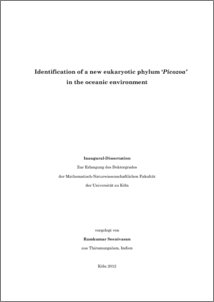Seenivasan, Ramkumar
(2013).
Identification of a new eukaryotic phylum ‘Picozoa’ in the oceanic environment.
PhD thesis, Universität zu Köln.

![[img]](https://kups.ub.uni-koeln.de/style/images/fileicons/application_pdf.png)  Preview |
|
PDF
Dissertation_Seenivasan.pdf
- Accepted Version
Download (6MB)
|
Abstract
Recent molecular phylogenetic analyses of picoeukaryotic (< 3 µm) 18S rDNA environmental sequences revealed a deep branching lineage formally described as ‘picobiliphytes’ with unknown affinity to other eukaryotes. Until now, no cultured representatives existed to enable further investigation regarding the biodiversity and morphology of this newly erected clade. This work, reports on a newly-discovered, free-living eukaryotic protist Picomonas judraskeda gen. et sp. nov., from European marine coastal habitats which has a ‘picobiliphyte’ 18S rDNA signature. Its morphological and ultra-structural characters clearly show that it contains, neither chlorophyll nor phycobilin autofluorescence, both of which are main attributes of ‘picobiliphytes’. The phycobilin was assumed to have been derived from a secondary endosymbiont; and the host of the ‘picobiliphytes’ was postulated to be a sister to cryptophytes/ katablepharids. The isolate Picomonas is slightly elongated and 2.5-5 µm in length with two unequal flagella. It exhibits unique cell movements (jump, drag, and skedaddle mode of locomotion). Light and electron microscopic studies reveal that the cells are naked, the flagella not covered by hairs or scales and that a plastid is lacking. The cells thus are heterotrophic, although their food source could not be determined and food vacuoles containing bacteria are never observed. The cells harbor several unique compartments that do not match those of any other known eukaryotes. This uniqueness is corroborated by phylogenetic analyses of the complete nuclear ribosomal operon placed them into a new phylum ‘Picozoa’.
| Item Type: |
Thesis
(PhD thesis)
|
| Translated abstract: |
| Abstract | Language |
|---|
| Molekulare phylogenetische Analysen von 18S rDNA Umwelt-Sequenzen wiesen auf eine neue Gruppe von Picoplanktern unbekannter Affinität zu anderen Eukaryoten. Vor einigen Jahren wurde diese Organismengruppe formal als „Picobiliphyta“' beschrieben. Eine Kultur dieser Organismen war bisher jedoch nicht möglich, sodass keine weitergehenden Untersuchungen in Bezug auf die Biodiversität und Morphologie dieser Organismengruppe möglich waren. In der hier vorgelegten Arbeit wurde nun erstmals eine Kultur etabliert angelegt und die Morphologie einer Gattung detailliert untersucht. Die Gattung hat den Namen, Picomonas judraskeda Gen. et sp. nov. Erhalten. Sie kommt an den europäischen Atlantikküste vor und besitzt eine typische ‘picobiliphyte‘ 18S rDNA Signatur . Licht- und elektronenmikroskopische Untersuchunge zeigen deutlich, sowie Untersuchungen der zellulären Autofluoreszenz zeigen eindeuting, dass sie weder Chlorophyll, Phycobiline oder einen Plastiden besitzt. Damit konnten wichtige frühere Befunde zu den "Picobiliphyta 'nicht bestätigt werden und Picomonoas judraskeda ist daher keine Alge mit sekundären Endosymbionten (Schwestergruppe zu den Cryptophyten und Katablephariden) sondern ein heterotropher Organismus.
Zellen von Picomonas sind etwas länglich, ca. 2-5 µm lang und besitzen zwei ungleiche Geißeln. Die Zellen zeigen einzigartige Fortbewegungen. Licht- und elektronenmikroskopische Untersuchungen zeigen, dass die Zellen nackt sind,und die Geißeln nicht durch Haare oder Schuppen bedeckt sind. Ein Plastid fehlt. Die Zellen sind somit heterotroph, obwohl leider ihre Nahrungsquelle bisher nicht bestimmt werden konnte. Nahrungsvakuolen mit Bakterien wurden bisher nicht beobachtet. Die Zellen besitzen mehrere einzigartige Membran-umhüllte Kompartimente, die nicht mit von anderen Eukaryoten bekannt sind. Diese Einzigartigkeit wird durch phylogenetische Analysen des vollständigen nuklearen ribosomalen Operons bestätigt. Daher wurden die Gattung Picomonas in einen neuen Stamm Picozoa eingeordnet. | German |
|
| Creators: |
| Creators | Email | ORCID | ORCID Put Code |
|---|
| Seenivasan, Ramkumar | rseeniva@uni-koeln.de | UNSPECIFIED | UNSPECIFIED |
|
| URN: |
urn:nbn:de:hbz:38-50785 |
| Date: |
19 March 2013 |
| Language: |
English |
| Faculty: |
Faculty of Mathematics and Natural Sciences |
| Divisions: |
Faculty of Mathematics and Natural Sciences > Department of Biology > Botanical Institute |
| Subjects: |
Life sciences |
| Uncontrolled Keywords: |
| Keywords | Language |
|---|
| ‘Picobiliphytes’, ‘biliphytes’, Picomonas judraskeda, PicoPCR, cell PCR, 18S rDNA, electron microscopy, Picozoa, TSA-FISH | UNSPECIFIED |
|
| Date of oral exam: |
23 January 2012 |
| Referee: |
| Name | Academic Title |
|---|
| Melkonian, Michael | Prof.Dr. | | Arndt, Hartmut | Prof. Dr. |
|
| Funders: |
German Research Foundation (DFG) grant no. ME 658/27-1, University of Cologne |
| Refereed: |
Yes |
| URI: |
http://kups.ub.uni-koeln.de/id/eprint/5078 |
Downloads per month over past year
Export
Actions (login required)
 |
View Item |


